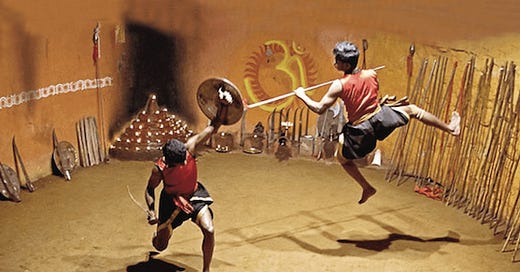Etching Avenues into the Brain
These are not accidental combinations, as is concluded by the ignorant interpretations of cognitive neuroscientists today, who are still waddling through the meanings of smells, tastes and emotional connections in the brain.
Etching Avenues into the Brain
The intelligent brain is created through etching patterns between stimulus and behavior, honed with practice again and again until the brain connects a stimulus with an action without our conscious recalculation. Known as classical conditioning by Pavlov, this sequence was known as the dhatu in ancient times. Among its myriad of meanings, the dhatu is a solid connection between a stimulus of energy of light or sound with the physical brain, and resulting in a movement or action.
Humans have 5 different avenues to express those dhatus. The first is the muscles of the throat that result in speech or song known as vak. The second is through actions of the feet and hands that speak through mudras. The third is through movement of the eyes that speak through expression and a subtle energy and heat. The fourth is the breath which allows us to fuel not only oxygen into our body but a lifeforce that propels and amplifies other actions. The fifth is coordinated movement of our trunk and limbs.
Ancient scholars quietly described 5000 dhatus. These are demonstrated by the experts of martial arts, especially the expert practitioners of the primordial art of kalaripayattu, practiced by traditional families of Kerala today. These dhatus are also expressed in a complete yoga practice, using the integrated form of mudra, mantra, drsti, pranayama and asana in each pose that is implemented during each session. Classical dance forms of India, described in the Natya Shastra also teach the hasti-mudras, the special meanings of glances and directions of the eyes, lip movements and facial expressions, body and foot movements and breath.
The 5000 dhatus align our bioelectrical beings with Nature of physics and chemistry in the Universe through light, sound, and electricity, all of which point toward electrons and atomic particles.
These are not accidental combinations, as is thought in the ignorant interpretations of cognitive neuroscientists today, who are still waddling through the meanings of smells, tastes and emotional connections in the brain. These combinations were prescribed in advanced texts that understood the effects of sound and light as energy.
Several modern sciences point toward these dhatus, without revealing their full formulas. Cymatics shows us the wave forms that occur on water or small particles with the systematic production of resonant sound. Light scattering phenomena also show us the power of rhythmic light. Focused light produces laser technology, just as focused sound produces ultrasound technology. The use of electric pulses has produced our EKGs, EEGs and EMGs for diagnosis. The diagnostic use of x-ray light has produced the entire radiology industry, and the therapeutic of x-ray light has produced the radiation technology industry. It is not unknown to modern science that light and sound are powerful and affect the human body.
Of the 5000 dhatus, 2000 are occupied by the relation of sound produced to make words in Sanskrt. These words come from dhatu forms, sometimes translated as roots. The sound representation in the language of Sanskrt comes from our nabhi (navel) through the sound produced in our heart, to our throat’s vocal cord muscles and up into that flat thick muscle known as the tongue, then out of our mouths. These dhatus are programmed in a language that stems from subtle energies that correlate with the subtle vibrational energy of the actions and all material phenomena around that action.
For example, the dhatu root √vac means to speak in Sanskrt. Pronouncing it correctly with the exact sound frequency aligns a connection between the electricity in the sound waves and the bioelectricity in the person. It then aligns our energies in our bodies and releases the power that occurs when our mind, body, senses and soul are aligned. The power of yoga lies in this understanding, which modern physics and biochemistry is just beginning to learn. They will take some years for scientists to communicate with each other and synthesize its practical use.
In the meantime, Ayurveda whispers that you can chant mantra, use mudra, drsti, pranayama and asana in each pose to tune your body in to its greater healing power.
week34. TheSouthAsianTimes
Download the .pdf version of this column by clicking on the image.
Dr. Bhaswati Bhattacharya is a Fulbright Specialist 2018‐2023 in Public Health. She serves as Clinical Asst Professor of Family Medicine in the Department of Medicine at Weill Cornell Medical College in New York, NY. Her bestselling book Everyday Ayurveda is published by Penguin Random House. To order an autographed copy, write to bhaswati@post.harvard.edu.
www.drbhaswati.com





